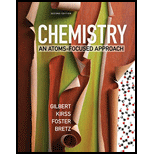
To find:
Net ionic equations and identify Bronsted-Lowry acids and bases
Answer to Problem 15.109QA
Solution:
a)
b)
c)
d)
e)
f)
g)
h)
Explanation of Solution
Concept:
The net ionic equation is a chemical equation that shows only the soluble and strong electrolytes reacting (ions) and omits the spectator ions which remain unchanged during the reaction.
According to Bronsted –Lowry acid base theory, acids are proton donors whereas bases are proton acceptors.
a)
Therefore the net ionic equation is:
So,
b)
Therefore the net ionic equation is:
c)
Therefore the net ionic equation is:
d)
Therefore the net ionic equation is:
e)
f)
g)
Therefore the net ionic equation is:
h)
Therefore the net ionic equation is:
Conclusion:
The net ionic equation is the equation that is left behind when all the spectator ions for both sides are cancelled out.
Want to see more full solutions like this?
Chapter 15 Solutions
Chemistry: An Atoms-Focused Approach (Second Edition)
 ChemistryChemistryISBN:9781305957404Author:Steven S. Zumdahl, Susan A. Zumdahl, Donald J. DeCostePublisher:Cengage Learning
ChemistryChemistryISBN:9781305957404Author:Steven S. Zumdahl, Susan A. Zumdahl, Donald J. DeCostePublisher:Cengage Learning ChemistryChemistryISBN:9781259911156Author:Raymond Chang Dr., Jason Overby ProfessorPublisher:McGraw-Hill Education
ChemistryChemistryISBN:9781259911156Author:Raymond Chang Dr., Jason Overby ProfessorPublisher:McGraw-Hill Education Principles of Instrumental AnalysisChemistryISBN:9781305577213Author:Douglas A. Skoog, F. James Holler, Stanley R. CrouchPublisher:Cengage Learning
Principles of Instrumental AnalysisChemistryISBN:9781305577213Author:Douglas A. Skoog, F. James Holler, Stanley R. CrouchPublisher:Cengage Learning Organic ChemistryChemistryISBN:9780078021558Author:Janice Gorzynski Smith Dr.Publisher:McGraw-Hill Education
Organic ChemistryChemistryISBN:9780078021558Author:Janice Gorzynski Smith Dr.Publisher:McGraw-Hill Education Chemistry: Principles and ReactionsChemistryISBN:9781305079373Author:William L. Masterton, Cecile N. HurleyPublisher:Cengage Learning
Chemistry: Principles and ReactionsChemistryISBN:9781305079373Author:William L. Masterton, Cecile N. HurleyPublisher:Cengage Learning Elementary Principles of Chemical Processes, Bind...ChemistryISBN:9781118431221Author:Richard M. Felder, Ronald W. Rousseau, Lisa G. BullardPublisher:WILEY
Elementary Principles of Chemical Processes, Bind...ChemistryISBN:9781118431221Author:Richard M. Felder, Ronald W. Rousseau, Lisa G. BullardPublisher:WILEY





